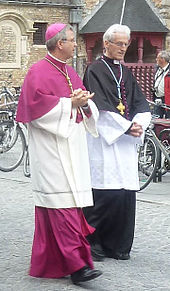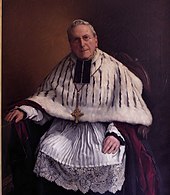Canon (priest)
![]()
Canonicus is a redirect to this article. For the chief of the Narraganset see Canonicus (Sachem).
![]()
Canonici is a redirect to this article. For the Italian Jesuit, teacher, bibliophile, and art collector Matteo Luigi Canonici (1727-1805), see Matteo Luigi Canonici.
![]()
This article is about ecclesiastical canons, also called canons; for other meanings see canon (disambiguation) and canon (music).
Canons, also called canons or canons, are clerics of all orders, mostly of the Roman Catholic or Anglican Church, who participate in the common liturgy as members of a cathedral chapter or a collegiate chapter at a cathedral, basilica or religious church (regular canons). By common liturgy is meant the celebration of Holy Mass and the Liturgy of the Hours, to which all priests are bound, whether alone or in community.
Hence the name "canon", which is derived from the ecclesiastical Latin term canonicus, which in turn goes back to the Greek (κανών "rule, rule" or κανονικός "regular, obligatory"). The times of the "canonical hours" (horae canonicae), that is, those of the Liturgy of the Hours, have been circumscribed in the Occident since the middle of the 6th century by the Rule of Benedict.
Canons live in community. The superior of a chapter is usually a provost; sometimes the leadership is entrusted to a dean or prior. Some chapters are headed directly by the diocesan bishop; at Roman patriarchal basilicas the superior holds the title of archpriest. The canons today are mostly engaged in pastoral work and are maintained more or less entirely out of the church estates.
A member of a cathedral chapter is called a cathedral chapter, and a member of a secular canonry or an order of regulated canons is called a canon or canon. Each of these chapters may also award the title of honorary canon to deserving clergymen, and in exceptional cases also to laymen of special rank.
Basically, one distinguishes between two types of canons: the regular canons, or regulated canons, whose community basis is usually the Rule of Augustine, and the secular canons, who live according to consuetudines, i.e. interpretations of monastic rules.

Bishop and canon (right), Bruges 2014

Canon in the late Middle Ages with the almutium over his left arm

Master of the Spes nostra: Canons and Saints at a Tomb or Allegory of Transience. ca. 1500

Flemish canon with almutium
History
The canon rule (regula canonicorum), developed on the model of Augustine as a distinction from (Benedictine) monasticism, was established in 755 by Bishop Chrodegang of Metz for his diocese, further developed at the Imperial Synod of Aachen by Emperor Louis the Pious (Louis I) and established as binding for the entire Carolingian Empire in 816. A community of secular clergy is called a collegiate foundation.
Since the middle of the 11th century, one observes a reform among the canons leading to regulated canons' orders. With the renunciation of property under the sign of the vita apostolica, there was a break with the Institutio canonicorum Aquisgranensis (Aachen Institution) of 816 and the formation of the regulated canonship. Regular canons (Augustinian canons) took a vow to their cathedral chapter (high chapter) or collegiate chapter (low chapter) and chose from the two Augustinian rules handed down, either the more moderate version Praeceptum / ordo antiquus or, following the stricter observance, the version Ordo monasterii / ordo novus. The Premonstratensian Order initiated by Norbert of Xanten (originating from 1120 in Prémontré/Northern France), for example, opted for the ordo novus.
The secular canons, who continued to exist alongside them, did not take vows and were often able to add the often rich canonical benefices of the foundation's assets to their private wealth from the 11th/12th century onwards. The pastoral duties often took a back seat and were then only carried out by vicars. The nobility in particular often used secular canon positions at monasteries to provide for their offspring and as a stepping stone to a career in the clergy or at court. A positive aspect of secular canonry was its significant role in the founding of universities in the late Middle Ages. The first professors of these newly founded universities were predominantly secular canons. Such collegiate foundations of secular canons were widespread in the Middle Ages, but were mostly transformed into Augustinian canons' monasteries and became very rare at the latest with the secularization.
Lifestyle
Although canons are obliged to keep the daily times of the Liturgy of the Hours, they differ from monks in their way of life, since they are usually charged with pastoral duties outside the monastery. Therefore, a worldly way of life would not be consistent with this activity. Nor do canons lead a cloistered life. For canons, the commandment of non-possession does not apply. Every canon may own his own property and is also endowed with benefices as a source of income.
Canons do not have to stay in their community for the whole year. They only have a "residence obligation" of a few months' duration. This residence obligation is regulated individually for each canon; thus it may well happen that a canon with a residence obligation of three months is a permanent member of another three foundations and is also endowed with benefices there. The head of a foundation is not an abbot, but a provost; the administrator of the foundation is called a dean.
Search within the encyclopedia